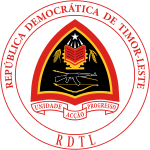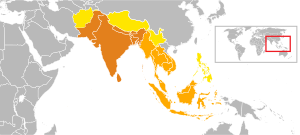
Timor is an island at the southern end of Maritime Southeast Asia, in the north of the Timor Sea. The island is divided between the sovereign states of East Timor in the eastern part and Indonesia in the western part. The Indonesian part, known as West Timor, constitutes part of the province of East Nusa Tenggara. Within West Timor lies an exclave of East Timor called Oecusse District. The island covers an area of 30,777 square kilometres. The name is a variant of timur, Malay for "east"; it is so called because it lies at the eastern end of the Lesser Sunda Islands. Mainland Australia is less than 500 km away, separated by the Timor Sea.
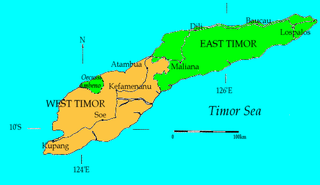
West Timor is an area covering the western part of the island of Timor, except for the district of Oecussi-Ambeno. Administratively, West Timor is part of East Nusa Tenggara Province, Indonesia. The capital as well as its main port is Kupang. During the colonial period, the area was named Dutch Timor and was a centre of Dutch loyalists during the Indonesian National Revolution (1945–1949). From 1949 to 1975 it was named Indonesian Timor.

Portuguese Timor was a colonial possession of Portugal that existed between 1702 and 1975. During most of this period, Portugal shared the island of Timor with the Dutch East Indies.
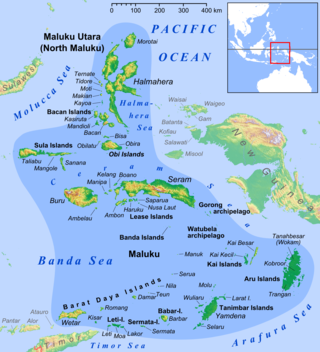
The Maluku Islands or the Moluccas are an archipelago in the eastern part of Indonesia. Tectonically they are located on the Halmahera Plate within the Molucca Sea Collision Zone. Geographically they are located east of Sulawesi, west of New Guinea, and north and east of Timor. Lying within Wallacea, the Moluccas have been considered a geographical and cultural intersection of Asia and Oceania.

The military history of the Philippines is characterized by wars between Philippine kingdoms and its neighbors in the precolonial era and then a period of struggle against colonial powers such as Spain and the United States, occupation by the Empire of Japan during World War II and participation in Asian conflicts post-World War II such as the Korean War and the Vietnam War. The Philippines has also battled a communist insurgency and a secessionist movement by Muslims in the southern portion of the country.

East Timor, officially the Democratic Republic of Timor-Leste, is a country in Southeast Asia and Oceania. The country comprises the eastern half of the island of Timor and the nearby islands of Atauro and Jaco. The first inhabitants are thought to be descendant of Australoid and Melanesian peoples. The Portuguese began to trade with Timor by the early 16th century and colonised it throughout the mid-century. Skirmishing with the Dutch in the region eventually resulted in an 1859 treaty for which Portugal ceded the western half of the island. Imperial Japan occupied East Timor during World War II, but Portugal resumed colonial authority after the Japanese surrender.

Great Timor refers to the irredentist concept of a united and independent island of Timor, which is currently divided between the independent state of East Timor and the Indonesian territory of West Timor. The concept of unifying the island has been raised since the mid-20th century.

The history of the arrival of Islam in Indonesia is somewhat unclear. One theory states that Islam arrived directly from Arabia as early as the 9th century, during the time of the Umayyad and Abbasid caliphates. Another theory credits Sufi travelers for bringing Islam in the 12th or 13th century, either from Gujarat in India or from Persia. Before the archipelago's conversion to Islam, the predominant religions in Indonesia were Hinduism and Buddhism.

East Timorese Portuguese, or Nusantaran Portuguese, is the variety of the Portuguese language spoken in Timor-Leste. It is one of the official languages of Timor-Leste alongside Tetum. As with other Lusophone countries besides Brazil, the Portuguese language curriculum in East Timor is based on European Portuguese, with some localisations in pronunciation. East Timor is the only sovereign state in Asia with Portuguese as an official language. There is a growing demand for Portuguese-language courses in the country, both at early-learning and tertiary levels of education.

The majority of the population of Timor-Leste is Christian, and the Catholic Church is the dominant religious institution, although it is not formally the state religion. There are also small Protestant and Sunni Muslim communities.
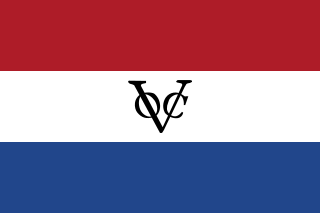
Company rule in the Dutch East Indies began when the Dutch East India Company appointed the first governor-general of the Dutch East Indies in 1610, and ended in 1800 when the bankrupt company was dissolved and its possessions were nationalized as the Dutch East Indies. By then it exerted territorial control over much of the archipelago, most notably on Java.

Wehali is the name of a traditional kingdom at the southern coast of Central Timor, now in Indonesia and East Timor. It is often mentioned together with its neighbouring sister kingdom, as Wewiku-Wehali (Waiwiku-Wehale). Wehali held a position of ritual seniority among the many small Timorese kingdoms.
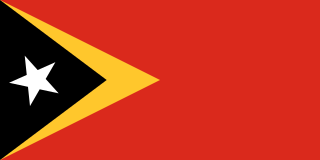
Timor-Leste, also known as East Timor, officially the Democratic Republic of Timor-Leste, is a country in Southeast Asia. It comprises the eastern half of the island of Timor, the exclave of Oecusse on the island's north-western half, and the minor islands of Atauro and Jaco. The western half of the island of Timor is administered by Indonesia. Australia is the country's southern neighbour, separated by the Timor Sea. The country's size is 14,950 square kilometres (5,770 sq mi). Dili, on the north coast of Timor, is its capital and largest city.

Luzones was a demonym used by Portuguese sailors in Malaysia during the early 1500s, referring to the Kapampangan and Tagalog people who lived in Manila Bay, which was then called Lusong. The term was also used for Tagalog settlers in Southern Tagalog region, where they created intensive contact with the Kapampangans.

In Philippine history, the Tagalog bayan of Maynila was one of the most cosmopolitan of the early historic settlements on the Philippine archipelago. Fortified with a wooden palisade which was appropriate for the predominant battle tactics of its time, it lay on the southern part of the Pasig River delta, where the district of Intramuros in Manila currently stands, and across the river from the separately-led Tondo polity.
Liurai is a ruler's title on Timor. The word is Tetun and literally means "surpassing the earth". It was originally associated with Wehali, a ritually central kingdom situated at the south coast of central Timor. The sacral lord of Wehali, the Maromak Oan enjoyed a ritually passive role, and he kept the liurai as the executive ruler of the land. In the same way, the rulers of two other important princedoms, Sonbai in West Timor and Likusaen (Liquica) in East Timor, were often referred as liurais, which indicated a symbolic tripartition of the island. In later history, especially in the nineteenth and twentieth centuries, the term liurai underwent a process of inflation. By this time it denoted any ruler in the Portuguese part of Timor, great or small. In the Dutch part in West Timor the title appears to have been restricted to the Sonbai and Wehali rulers. The rulers in the west were known by the Malay term raja, while there were internally used terms such as usif (lord) among the Dawan-speaking groups, and loro (sun) among the Tetun speakers.

Southeast Asia was in the Indian sphere of cultural influence from 290 BCE to the 15th century CE, when Hindu-Buddhist influences were incorporated into local political systems. Kingdoms in the southeast coast of the Indian subcontinent had established trade, cultural and political relations with Southeast Asian kingdoms in Burma, Bhutan, Thailand, the Sunda Islands, Malay Peninsula, Philippines, Cambodia, Laos, and Champa. This led to the Indianisation and Sanskritisation of Southeast Asia within the Indosphere, Southeast Asian polities were the Indianised Hindu-Buddhist Mandala.
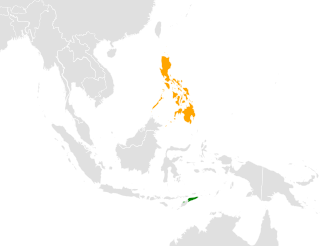
East Timor–Philippines relations refer to foreign relations between East Timor and the Philippines. The Philippines was actively involved in the United Nations peacekeeping forces in East Timor during its move towards independence. When several nations recognized East Timor's sovereignty, the Philippines began official diplomatic relations between the two governments with the establishment of an embassy in Dili and East Timor established its embassy in Pasig.
Luso-Asians are Eurasian people whose ethnicity is partially or wholly Portuguese and ancestrally are based in or hail primarily from Portugal, South Asia, Southeast Asia, and East Asia. They historically came under the cultural and multi-ethnic sway of the Portuguese Empire in the East and retain certain aspects of the Portuguese language, Roman Catholic faith, and Latin cultural practices, including internal and external architecture, art, and cuisine that reflect this contact. The term Luso comes from the Roman empire's province of Lusitania, which roughly corresponds to modern Portugal.

Chinese people in East Timor consist of Chinese migrants to East Timor and their descendants. The Chinese minority is a small proportion of the East Timorese population and most are Hakka and a small number of Cantonese within the populace. Many Chinese left during the mid-1970s.
